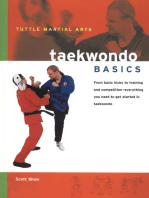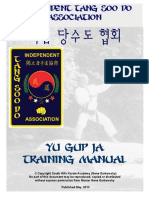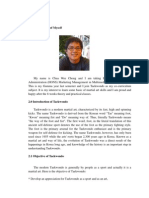Taekwondo, 10 9
Taekwondo, 10 9
Uploaded by
1946688564Copyright:
Available Formats
Taekwondo, 10 9
Taekwondo, 10 9
Uploaded by
1946688564Original Title
Copyright
Available Formats
Share this document
Did you find this document useful?
Is this content inappropriate?
Copyright:
Available Formats
Taekwondo, 10 9
Taekwondo, 10 9
Uploaded by
1946688564Copyright:
Available Formats
Taekwondo is a Korean martial art and combat sport that have five tenets of courtesy,
integrity, perseverance, self-control and indomitable spirit, also requires three physical
skills: poomsae (품새), kyorugi (겨루기) and gyeokpa (격파). Taekwondo is one of the
official events of the modern Olympic Games which rose to worldwide popularity,
especially young people.
This study is motivated by introduce Taekwondo more in-deep introduction, including
the history of Taekwondo, Oath and Tenets of Taekwondo and belt hierarchy in
Taekwondo.
Where Taekwondo come from? Taekwondo has been developing with a long history
of Korea, being called by several different names in the course. After the World War II
and the Japanese occupation, new martial arts school called kwans opened in Seoul.
At that time, kwans was considered as combain of Japanese and Chinese martial arts.
Because the founders were study in Japan and China. The South Korean government,
interested in promoting a national martial art, pressured the kwans to complete the
unification of the Korean martial arts. In 1955, Choi Hong-hi advocated the use of the
name "Tae Kwon Do". In 1959, the name Taekwondo was chosen to unify the arts and
the Korea Taekwondo Association was formed to serve as the central body of the
main kwans with Choi as its President. "Tae Kwon Do" composed of three parts as
shown in the English spelling, though it is one word in Korean. "Tae" means "foot,"
"leg," or "to step on"; "Kwon" means "fist," or "fight"; and "Do" means the "way" or
"discipline."
Taekwondo can be characterized by unity: the unity of body, mind, and life. A
Courtesy, 예의 in Korean Hangul (pronounced ye-wee).
Integrity, 염치 in Korean Hangul (pronounced yom-chee).
Perserverance, 인내 in Korean Hangul (pronounced een-nay).
Self-control, 극기 in Korean Hangul (pronounced gook-gee).
ndomitable Spirit, 백절불굴 in Korean Hangul (pronounced beckjool boolgool).
Oath and Tenets of
Taekwondodfdjnfjksdnjkdnjnfkfndjknfffjdfhbfvwedghxasjnlksjfasgdfugfuhdkjdjcnjbc
hbchbdhfhyeyyyyfdsbbbbbbbbbbbbbbbbbbbbbbbbbbbbbbbbbbbbbbbbbbbbbbbbbbbb
b
You might also like
- Taekwondo Basics: Everything You Need to Get Started in Taekwondo - from Basic Kicks to Training and CompetitionFrom EverandTaekwondo Basics: Everything You Need to Get Started in Taekwondo - from Basic Kicks to Training and CompetitionRating: 5 out of 5 stars5/5 (1)
- Independent Tang Soo Do Association: Yu Gup Ja Training ManualDocument54 pagesIndependent Tang Soo Do Association: Yu Gup Ja Training Manualbrendan lanzaNo ratings yet
- TaekwondoDocument10 pagesTaekwondoJeremy LobricoNo ratings yet
- LMA Taekwondo Hapkido ManualDocument50 pagesLMA Taekwondo Hapkido ManualNoel Gilchrist100% (7)
- The History and Development of The Martial ArtsDocument2 pagesThe History and Development of The Martial ArtsMădălina NanuNo ratings yet
- Soo Bahk Do - Sam Dan EssayDocument2 pagesSoo Bahk Do - Sam Dan Essaywolfe42048100% (1)
- TaekwondoDocument15 pagesTaekwondoscripduser1973100% (2)
- Phed TKDDocument39 pagesPhed TKDcutieNo ratings yet
- Blackbelt HandbookDocument15 pagesBlackbelt HandbookDenmas DityoNo ratings yet
- Introduction of TaekwondoDocument7 pagesIntroduction of TaekwondoKen Lip YamNo ratings yet
- History of Taekwondo As Martial Arts and As Fitness: Tenebro, Hannah A. Bsce 1 7815 FIT CS 3:30-5:30Document3 pagesHistory of Taekwondo As Martial Arts and As Fitness: Tenebro, Hannah A. Bsce 1 7815 FIT CS 3:30-5:30Jansen Taruc NacarNo ratings yet
- History of Taekwondo and Hand Attacks.Document4 pagesHistory of Taekwondo and Hand Attacks.Niña LoricoNo ratings yet
- Martial ArtsDocument19 pagesMartial Artsalcodark100% (1)
- Tae Kwon DoDocument6 pagesTae Kwon DoOremor YmerNo ratings yet
- Taekwondo Taekwondo (태 권 도 ;Document10 pagesTaekwondo Taekwondo (태 권 도 ;zazasharkNo ratings yet
- Introduction of TaekwondoDocument28 pagesIntroduction of Taekwondoalex100% (1)
- Taekwondo: Meaning of The Word "Taekwondo"Document7 pagesTaekwondo: Meaning of The Word "Taekwondo"Faith ArominNo ratings yet
- Taekwondo EssayDocument4 pagesTaekwondo EssayAlan V-Neck NguyenNo ratings yet
- HOPE 2 Individual & Dual SportsDocument18 pagesHOPE 2 Individual & Dual SportsMarcelo SakitingNo ratings yet
- Black Belt Thesis HistoryDocument3 pagesBlack Belt Thesis Historyapi-230077913No ratings yet
- Research PaperDocument12 pagesResearch Paperapi-549127950No ratings yet
- Taekwondo WikipediaDocument31 pagesTaekwondo WikipediapaderescherryroseNo ratings yet
- Path FitDocument3 pagesPath FitZyrine Ann UchayanNo ratings yet
- A Brief History of TaekwondoDocument12 pagesA Brief History of TaekwondoJoe WillertNo ratings yet
- A Brief History of TaekwondoDocument3 pagesA Brief History of Taekwondoganica castroNo ratings yet
- History of Taekwand1Document3 pagesHistory of Taekwand1Eka MagsigayNo ratings yet
- (PE) TaekwondoDocument4 pages(PE) Taekwondoaz.hbizNo ratings yet
- History of TaekwondoDocument3 pagesHistory of TaekwondosevenNo ratings yet
- History of Tae Kwon DoDocument12 pagesHistory of Tae Kwon DoRome John Mapiot GeminaNo ratings yet
- Choi Hong HiDocument2 pagesChoi Hong HiMary Bernadette FerolinNo ratings yet
- Pe TaekwondoDocument4 pagesPe TaekwondoalliahnahNo ratings yet
- Mtphed1 3Document4 pagesMtphed1 3Kyle SoveranoNo ratings yet
- Taekwondo oDocument6 pagesTaekwondo oAnn Dela PiezaNo ratings yet
- TKD UsaDocument36 pagesTKD UsaJose Pablo VenegasNo ratings yet
- TaekwondoDocument2 pagesTaekwondoMaha DhinaharNo ratings yet
- Taekwondo Thesis 4th DanDocument4 pagesTaekwondo Thesis 4th Danmaureennonweilertulsa100% (2)
- NamasteDocument2 pagesNamasteMarta DanielsNo ratings yet
- The History of TaewkondoDocument2 pagesThe History of TaewkondoPhilip TamNo ratings yet
- What Is TaekwondoDocument2 pagesWhat Is TaekwondoLibagon MpsNo ratings yet
- Group 1Document16 pagesGroup 1Kaiser Jacob FlorescaNo ratings yet
- Tae Kwon Do: The Ultimate Reference Guide to the World's Most Popular Martial Art, Third EditionFrom EverandTae Kwon Do: The Ultimate Reference Guide to the World's Most Popular Martial Art, Third EditionNo ratings yet
- Literature ReviewDocument5 pagesLiterature Reviewapi-549127950No ratings yet
- Taekwondo: Early KoreaDocument2 pagesTaekwondo: Early Korea0323-2404No ratings yet
- EKA ManualDocument37 pagesEKA Manualtuktuk.rghNo ratings yet
- Original 9 Kwans Tae Kwon Do Blase Di CioccioDocument6 pagesOriginal 9 Kwans Tae Kwon Do Blase Di CioccioparasharaNo ratings yet
- Pe 1 Fundamentals of Martial ArtsDocument26 pagesPe 1 Fundamentals of Martial ArtsRovi Clarito100% (6)
- The Influence of Korean Nationalism On TDocument24 pagesThe Influence of Korean Nationalism On TLuisNo ratings yet
- Taekwondo ReportDocument15 pagesTaekwondo ReportrynowaandreaademNo ratings yet
- The History of Tang Soo DoDocument3 pagesThe History of Tang Soo DoshafiraNo ratings yet
- Week 1 To 5 Prelim 1st SemDocument22 pagesWeek 1 To 5 Prelim 1st Semavi901136No ratings yet
- TongbeiquanDocument4 pagesTongbeiquancorneliuskooNo ratings yet
- Taekwondo, Tae Kwon Do or Taekwon-Do (: ListenDocument1 pageTaekwondo, Tae Kwon Do or Taekwon-Do (: ListenMatt DemonNo ratings yet
- TaekwondoDocument38 pagesTaekwondoJohn OliquianoNo ratings yet
- Taekwondo, Tae Kwon Do or Taekwon-Do (: ListenDocument1 pageTaekwondo, Tae Kwon Do or Taekwon-Do (: ListenkylaNo ratings yet
- History of KarateDocument11 pagesHistory of KarateJuliana Cortez0% (1)
- What Is Taekwondo: (Or 'To Step On Fists')Document5 pagesWhat Is Taekwondo: (Or 'To Step On Fists')Pedro ChavezNo ratings yet
- The Early Globalization Process of TaekwDocument33 pagesThe Early Globalization Process of TaekwLuisNo ratings yet
- History of Taekwondo in MalaysiaDocument17 pagesHistory of Taekwondo in Malaysiaiffah16100% (1)
- KarateDocument14 pagesKaratePulkit FarsaiyaNo ratings yet



























































